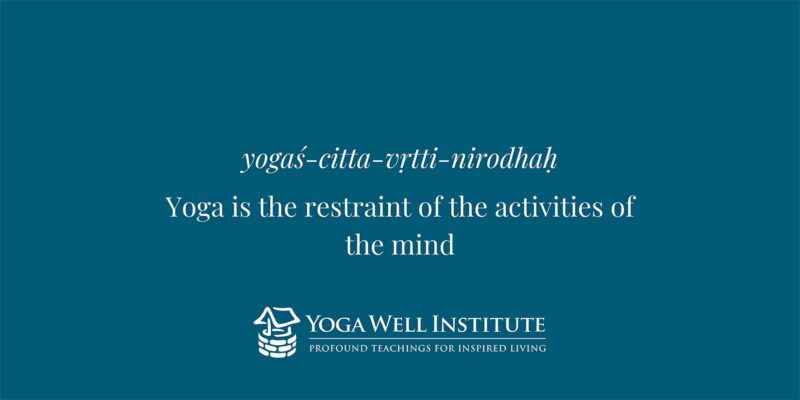When we talk about Yoga, what we’re really talking about is the behavior of the mind.
This is clear from the first chapter of the Yogasūtras, in which Patañjali says: yogaś-citta-vṛtti-nirodhaḥ (YS I.2), or “Yoga is the restraint of the activities of the mind.”
In this case, restraint (nirodhaḥ) should not be taken to mean withdrawal. Rather, it means putting your attention in one place, and not letting it go elsewhere. Directing your attention seems like an easy thing to do, but it’s only possible when you are in a relatively balanced state.
The purpose of Yoga, at least intially, is to bring your system into balance — because when your system moves toward balance, the mind becomes more directable.

So how do you come into balance?
By doing activities that mimic the characteristics of a state of balance — feeling peaceful, focusing on something, breathing in a long and smooth way, etc. This is a fundamental piece of how many Yoga techniques such as: poses (āsana), breathing (prāṇāyāma), chanting (mantra), meditation, etc. work.
It’s not just Yoga practices that can help you come into balance.
Every experience influences how your system is functioning — watching the news, going for a walk in the woods, having a fight with a friend. Some of these are peaceful experiences, others are stressful. Some will bring you toward balance, others will move you away.
The way that your system functions overall depends on the series of experiences that you’ve had.
As a path, what Yoga does is provide you with opportunities to intentionally create experiences that will be useful for balancing your system and beyond.
Yoga empowers you to change your mind. It provides a pathway for you to participate in how you are doing and how your system is functioning.
For example, when you try to meditate every day, whether or not you are successful, you are attempting to direct the mind. As we’ve explored, a directable mind is a characteristic of balance, and so attempting to direct the mind through your meditation practice itself will slowly bring your system towards balance.
So why not just sit down and meditate?
You could. And some people do.
But if your system is out of balance, you will have a harder time directing your mind when you try to meditate. However, if you do āsana and prāṇāyāma first — which ideally will bring you toward balance — you are likely to have an easier time keeping your attention where you want it to stay.
While meditation is often included in Yoga classes, it doesn’t only have to happen on a Yoga mat or meditation cushion. And it’s not just something that you do for fifteen minutes at the beginning or end of the day. In every activity, you have varying degrees of attention.
You can practice directing the mind anytime you are awake.
In doing this it is helpful to ask yourself throughout the day: Where’s my attention now? Am I letting my attention be drawn somewhere? Or I am choosing the things that I place my attention on? As we become more attentive more of the time, it strengthens the patterns related to balance.
Meditation is a means towards being in a state of Yoga.
When your system is balanced, the quality of the mind improves, then the way that you perceive — and respond to — the world shifts. It becomes different from the way you react when you’re stressed or angry or anxious.
As a regular practice brings you toward balance, you develop more clarity about the way situations in your life are affecting you. You also become better at navigating those situations and eliminating the negative and reinforcing the positive.
This is the message of Yoga.
So if you practice regularly and become balanced, then you will become established in yourself — more authentic — both on a material level and a spiritual level.
Meditation Near Me
Explore short, simple and accessible, yet powerful, breathing and meditation practices that explore a broad range of techniques and focuses with Yoga Well Institute.
15-minute Breathing and Meditation focuses on different breathing techniques and meditation focuses. After the last practice of each month, we meet for 40-60 minutes to discuss the design and intent of that month’s practices as well as share experiences.
This class is a fantastic way to get acquainted with a broad range of prāṇāyāma and meditation techniques and to deepen your experience of these important Yoga practices.
Join 15-minute Breathing and Meditation

Shawn Radcliffe
Shawn Radcliffe is a writer and yoga teacher in Ontario, Canada. His writing has appeared in print and digital publications such as Healthline, Science & Nonduality, Men’s Health, and others. He began his yoga teacher training in Portland, Oregon, including viniyoga and other styles. When he’s not at the computer or on a yoga mat, Shawn is often backpacking, bicycling, or wandering the streets of a new city. Connect with him on his website or Twitter.
